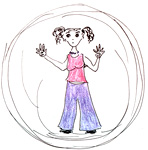
September 23, 2009
zora neale hurston
Posted by dogpossum on September 23, 2009 1:55 PM in the category lindy hop and other dances and music | Comments (1)
I keep returning to Zora Neale Hurston.

Negro dancing is a dynamic suggestion. No matter how violent it may appear to the beholder, every posture gives the impression that the dancer will do much more. For example, the performer flexes one knee sharply, assumes a ferocious face mask, thrusts the upper part of the body forward with clenched fists, elbows taut as in hard running or grasping a thrusting blade. That is all. But the spectator himself adds the picture of ferocious assault, hears the drums and finds himself keeping time with the music and tensing himself for the struggle. It is compelling insinuation. That is the very reason the spectator is held so rapt. He is participating in the performance himself – carrying out the suggestions of the performer.The difference in the two arts is: the white dancer attempts to express fully; the Negro is restrained, but succeeds in gripping the beholder by forcing him to finish the action the performer suggests. Since no art can ever express all the variations conceivable, the Negro must be considered the greater artist, his dancing is realistic suggestion, and that is about all a great artist can do (Zora Neal Hurston)
Hurston, Zora Neale, "Characteristics of Negro Expression" The Jazz Cadence of American Culture. Ed. Robert G. O’Meally, 1998. New York: Columbia University Press, 298-310.
(I can't find the original date for this right now - will look later).
I like this discussion of performer/spectator interaction, and the necessity of spectators participating in the performance. This is call-and-response at another level.





Comments
Posted by: Laura at September 24, 2009 11:48 PM
That's great. It's exactly her method in fiction as well - to work in suggestions that the reader completes.
Posted by: Laura at September 24, 2009 11:48 PM
Post a comment